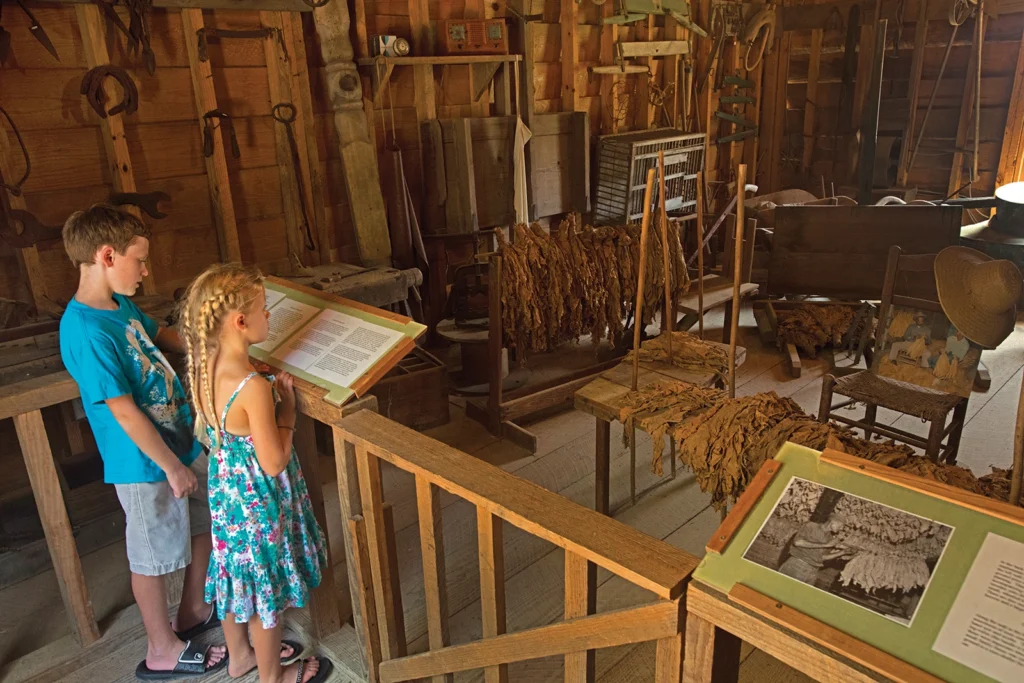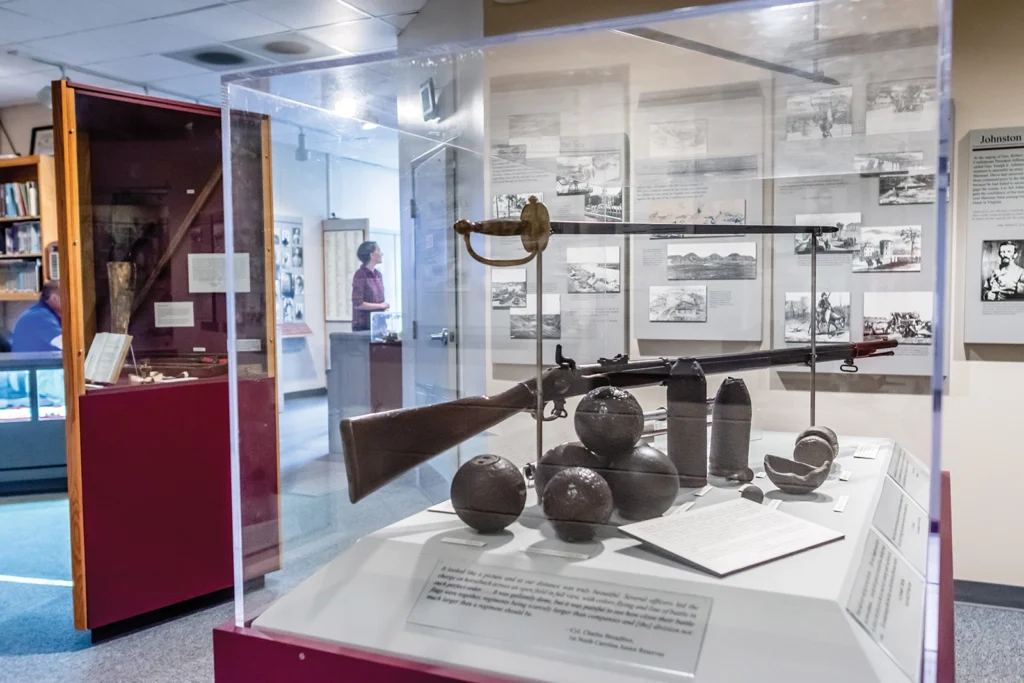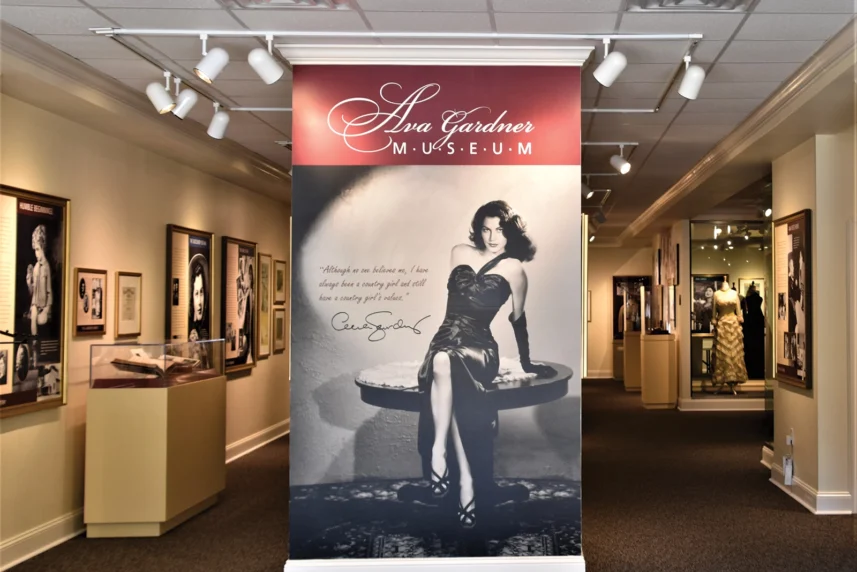Article:
BY MARILYN JONES
Less than an hour east of Raleigh, rural Johnston County offers excellent sites for North Carolina history lovers. Johnston County is the birthplace of Hollywood legend Ava Gardner, the site of a significant Civil War battlefield and home to a rich agricultural heritage celebrated through local museums.
The Ava Gardner Museum in Smithfield is a great place to start exploring. The community of just over 11,000 residents offers a museum chronicling the star’s movies, marriages and awards. Paintings, portraits, photos, clothing, jewelry and film posters help tell the story of her success in film and later in television.
Gardner was a leading lady during Hollywood’s Golden Age. Born on December 24, 1922 in Grabtown, North Carolina—about an hour from Smithfield—the actress and singer first signed a contract with Metro-Goldwyn-Mayer (MGM) in 1941. She appeared mainly in minor roles until 1946, when she performed in Robert Siodmak’s film noir “The Killers.”
She was nominated for an Academy Award for Best Actress for her performance in John Ford’s “Mogambo” in 1953 and Best Actress for both a Golden Globe Award and BAFTA Award for her performance in John Huston’s “The Night of the Iguana” in 1964.
Her personal life, meanwhile, drew national attention, including widely publicized marriages to screen idol Mickey Rooney, jazz musician Artie Shaw, and screen star and singer Frank Sinatra, all of which ended in divorce.
In 1999, the American Film Institute ranked Gardner No. 25 on their list of greatest female screen legends of classic American cinema. She continued to act regularly until 1986, four years before she died in 1990.

The Ava Gardner museum offers rich insight into Gardner’s life. Viewing her jewelry, clothing and other personal items, visitors get an idea of both the woman and her era.
Bentonville Battlefield, near Four Oaks, saw the last full-scale Civil War action and the largest battle fought in North Carolina.
A welcome center offers excellent exhibits that help explain the battle and showcase relics from the war. Tours are available throughout the day at the Harper House, which was used as a hospital for both Union and Confederate soldiers.
The site includes a Confederate mass grave, the Harper family cemetery and Union earthworks. In addition, visitors can pick up an informational map marking all the sites, including highway historical markers and waysides highlighting the battles that took place in the area.
Other museums in Johnston County teach about the agricultural history of the area. At the Tobacco Farm Life Museum in Kenly, visitors can learn the history of tobacco farming in North Carolina and what life was like on historic tobacco farms.
For many years, Johnston County’s economy, like much of the rest of North Carolina’s, depended heavily on tobacco. In the late 1800s, plummeting cotton prices forced farmers to find a new cash crop in bright leaf tobacco. Farmers established a tobacco market in 1898, and the crop salvaged rural North Carolina’s economy.

The ensuing prosperity brought telephone lines to practically every town in Johnston County. Townsfolk soon found themselves with electric lights and running water. Families of wealth built stately homes in town and in the country, and new schools and churches were erected.
Many farmers would have lost their land without the money tobacco brought to North Carolina farm families. The Tobacco Farm Life museum began as an educational project to show people how important tobacco farming was in the life of rural North Carolina.
Soon, farm families started donating equipment and other items that were used by residents for decades to plant tobacco. From the clothes they wore to the tools they used, these items offer a unique perspective into the life of a North Carolina tobacco farmer.
Today, the 6,000-square-foot museum looks at farming, business and farm life during the 1930s. Exhibits range from early harvesting techniques and tobacco auctioning to soil conservation and tobacco advertising. Visitors can also tour an entire farmstead on the museum site, from an authentic log tobacco barn and farmhouse to a kitchen and smokehouse.
The Benson Museum of Local History offers exhibits dating back to the 18th century, when the Tuscarora Native American tribe members were forced off their land. The museum features an expansive exhibit floor including displays on agricultural heritage, arts and crafts, local businesses, railroad history, fashion and heroes.
The Johnston County Heritage Center also answers visitor questions about life in this area. The museum preserves the history and material culture of the county for the educational benefit of its citizens and visitors.
Check out more from around the Triangle at midtownmag.com.



